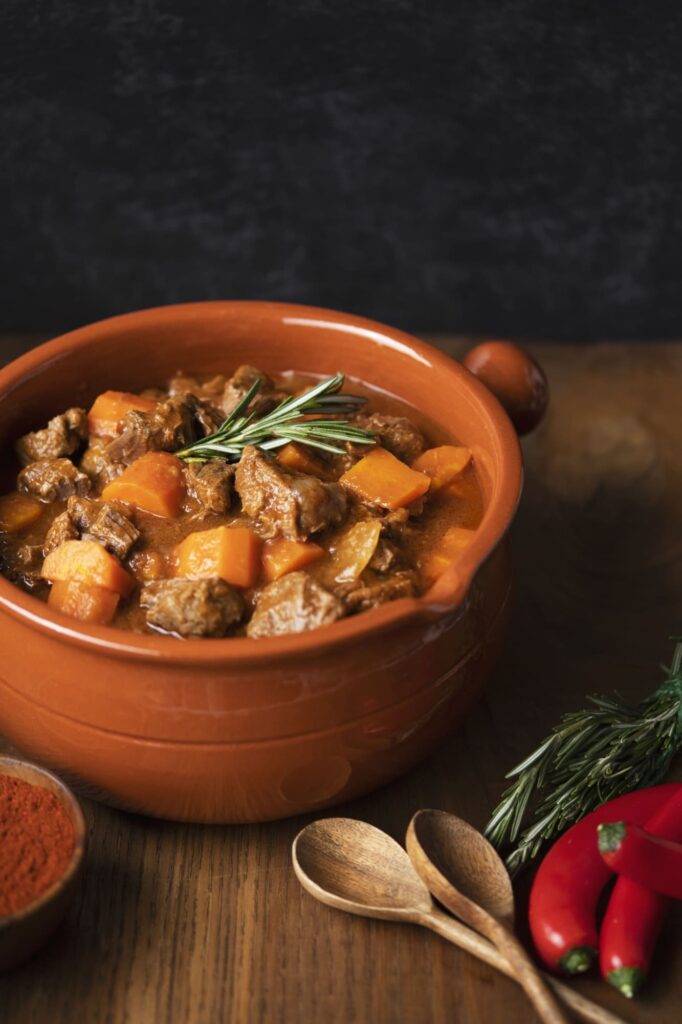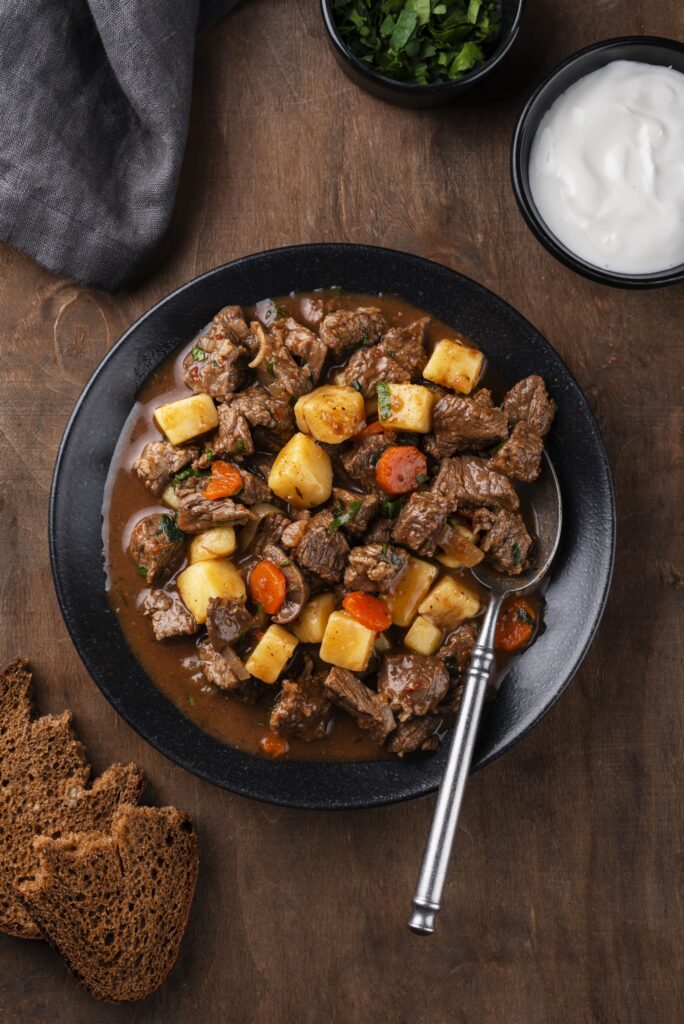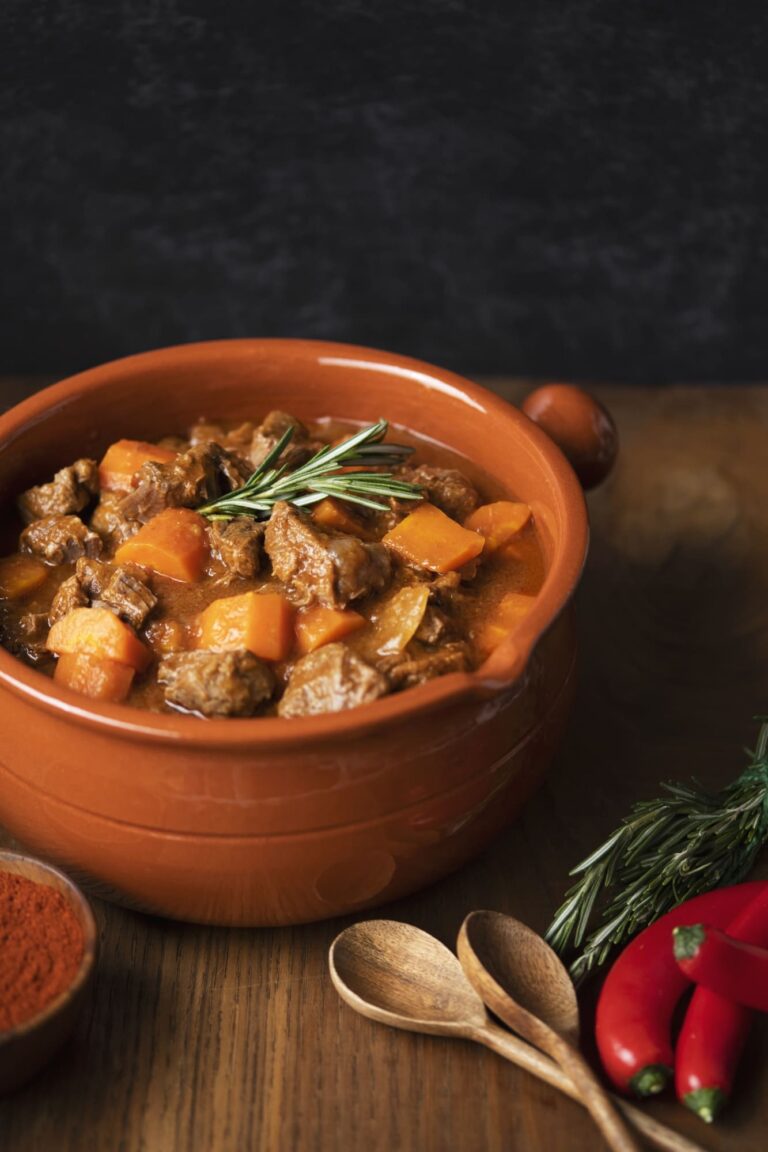Introduction
There’s something undeniably satisfying about a warm bowl of stew on a chilly day, and when it comes to comfort food, beef and sweet potato stew stands out as a classic favorite. This dish combines the hearty richness of tender beef with the natural sweetness of sweet potatoes, creating a flavor-packed meal that feels like a warm hug in a bowl. Both beef and sweet potatoes are nutritional powerhouses, offering protein, vitamins, and antioxidants that make this stew as healthy as it is delicious.
One of the reasons beef and sweet potato stew is so beloved is its versatility. It’s a one-pot wonder that can be easily customized to suit different tastes and dietary preferences. Whether you’re adding a touch of spice, experimenting with fresh herbs, or incorporating seasonal vegetables, this stew adapts beautifully to your creativity. It’s perfect for busy weeknights, meal prepping, or even impressing guests with minimal effort.
Beyond its incredible flavor, this stew is also a nutritional powerhouse. Sweet potatoes bring a boost of fiber, vitamins, and antioxidants, while beef provides a healthy dose of protein and iron, making it a well-balanced and satisfying meal. Together, they create a dish that not only tastes amazing but also supports your health goals.
If you’re searching for a recipe that delivers cozy vibes, rich flavors, and wholesome benefits, look no further than beef and sweet potato stew. Let’s dive into what makes this dish so special and how you can create the perfect version in your own kitchen.

Why Beef and Sweet Potato Are a Perfect Pair
When it comes to crafting a wholesome, satisfying meal, beef and sweet potatoes are a culinary match made in heaven. Their complementary flavors and nutritional benefits create a harmonious balance, making them a favorite duo in kitchens around the world. Let’s take a closer look at why these two ingredients work so well together.
Nutritional Benefits of Sweet Potatoes
Sweet potatoes are a nutritional powerhouse that bring more to the table than just their naturally sweet and earthy flavor. Here’s why they’re a standout ingredient:
- Rich in Fiber: Sweet potatoes are high in dietary fiber, which supports healthy digestion and helps you feel full longer. This makes them an ideal addition to a hearty stew that satisfies hunger.
- Packed with Vitamins: Loaded with vitamins like A, C, and B6, sweet potatoes contribute to better immune function, improved skin health, and energy production. Vitamin A, in particular, is present in the form of beta-carotene, which supports eye health and acts as a powerful antioxidant.
- Antioxidant Properties: Sweet potatoes contain a range of antioxidants that help combat inflammation and oxidative stress in the body. These antioxidants are essential for promoting overall health and reducing the risk of chronic diseases.
- A Healthy Carb Option: Unlike refined carbs, sweet potatoes provide complex carbohydrates that release energy slowly, making them a perfect addition to a meal that fuels you for hours.
Their natural sweetness and creamy texture also create a comforting and hearty element in dishes like stew, making them an excellent complement to savory beef.
Why Beef Adds Richness and Flavor
Beef is the cornerstone of many stews, providing richness and depth of flavor that make these dishes so irresistible. Here’s why beef is a key player in the perfect stew:
- Protein-Packed Goodness: Beef is an excellent source of high-quality protein, essential for muscle repair, growth, and overall health. It also supplies important nutrients like iron, zinc, and B vitamins, which support energy levels and immune function.
- Versatility in Cooking: From tender chunks to slow-cooked shredded beef, this protein adapts beautifully to different cooking techniques, making it a favorite in hearty recipes like stew.
- Flavor Enhancer: When browned properly, beef develops a caramelized crust that adds an incredible depth of flavor to the dish. Its juices infuse the broth, creating a savory base that balances the natural sweetness of sweet potatoes.
Tips for Choosing the Best Cuts for Stews:
- Opt for well-marbled cuts like chuck roast, brisket, or short ribs. These cuts become tender and flavorful during slow cooking.
- Avoid lean cuts like sirloin, as they can become dry and tough when simmered for long periods.
- Look for cuts labeled “stew meat” at your local butcher or grocery store for a convenient option.
Together, beef and sweet potatoes create a dish that’s not only delicious but also nutritionally balanced and satisfying. Their complementary textures and flavors ensure that every bite of your stew is rich, hearty, and wholesome.
Key Ingredients for the Perfect Beef and Sweet Potato Stew
A truly delicious beef and sweet potato stew starts with high-quality, fresh ingredients that come together to create a symphony of flavors. While the core components are simple, each one plays a critical role in achieving the stew’s signature richness and comfort. Let’s dive into the essentials and optional add-ins that elevate this dish to new heights.
Fresh and Essential Ingredients
Every great stew begins with carefully chosen ingredients that form the foundation of flavor and texture. Here’s what you’ll need:
- Beef:
- The star of the dish, beef provides the protein and savory richness that makes the stew hearty and satisfying.
- Recommended Cuts: Opt for well-marbled cuts like chuck roast, brisket, or short ribs. These cuts are perfect for slow cooking, breaking down into tender, flavorful bites.
- Tips for Preparation: Trim excess fat, cut into evenly sized chunks for even cooking, and sear the meat before adding it to the stew to enhance flavor.
- Sweet Potatoes:
- Sweet potatoes add natural sweetness, creaminess, and a dose of nutrients to the stew. Their earthy flavor pairs beautifully with the savory beef.
- How to Choose the Best Sweet Potatoes: Look for firm, smooth-skinned sweet potatoes without bruises or soft spots. The smaller to medium-sized ones tend to be sweeter and creamier than larger ones.
- Aromatics:
- A good stew relies on a robust flavor base, and aromatics like onions, garlic, and spices are essential for this.
- Onions and garlic should be fresh, finely chopped, and sautéed until fragrant to release their full potential.
- Spices like paprika, cumin, or a hint of cinnamon can add depth and warmth to the dish.
- Broth:
- The liquid foundation of your stew, the broth ties all the flavors together.
- Options: Beef broth is the classic choice for a rich and savory stew, but chicken or vegetable broth can also work if you prefer a lighter flavor.
- To enhance the broth, consider adding a splash of red wine or Worcestershire sauce for extra depth.
Optional Add-Ins to Enhance Flavor
While the essential ingredients provide the backbone of the dish, optional add-ins can take your beef and sweet potato stew to the next level:
- Vegetables:
- Additional vegetables bring color, texture, and nutrients to the stew. Popular options include:
- Carrots: Add a touch of sweetness and hold their shape well during cooking.
- Celery: Enhances the overall flavor with a subtle, earthy note.
- Tomatoes: Fresh or canned tomatoes can add acidity and balance the richness of the beef.
- Additional vegetables bring color, texture, and nutrients to the stew. Popular options include:
- Herbs:
- Fresh or dried herbs infuse the stew with aromatic depth. Consider using:
- Thyme: A classic herb that pairs beautifully with beef.
- Rosemary: Adds a fragrant, slightly piney flavor.
- Bay Leaves: A single bay leaf simmered in the stew contributes subtle, savory notes.
- Fresh or dried herbs infuse the stew with aromatic depth. Consider using:
By combining fresh, high-quality essential ingredients with thoughtfully chosen add-ins, you can create a beef and sweet potato stew that is rich, flavorful, and unforgettable. The beauty of this dish is its adaptability, allowing you to customize it to your taste and make it your own.

Step-by-Step Guide to Making Beef and Sweet Potato Stew
Cooking beef and sweet potato stew is a rewarding process that transforms simple ingredients into a rich and flavorful dish. This step-by-step guide ensures you get the best results every time, with techniques that maximize flavor and texture.
Preparing the Ingredients
Preparation is key to a seamless cooking experience and a delicious end result. Follow these steps for perfect preparation:
- How to Chop and Season Beef and Sweet Potatoes:
- Beef: Use a sharp knife to cut your beef into uniform chunks, approximately 1 to 1.5 inches in size. This ensures even cooking. Pat the beef dry with paper towels to remove moisture, which helps achieve a good sear. Season generously with salt, pepper, and optional spices like paprika or garlic powder.
- Sweet Potatoes: Peel the sweet potatoes and cut them into medium-sized cubes, about the same size as the beef chunks. This ensures they cook evenly and maintain their texture without becoming mushy.
- Best Practices for Prepping Aromatics and Spices:
- Aromatics: Chop onions finely and mince garlic to create a fragrant base. For a smoother texture, you can grate the garlic.
- Spices: Measure your spices ahead of time to streamline the cooking process. Toasting spices lightly in the pan (before adding liquid) can enhance their aroma and depth.
Cooking Techniques for Maximum Flavor
Getting the cooking process right is essential for a stew that is both rich and satisfying. Here’s how to do it:
- Browning the Beef for Richness:
- Heat a large, heavy-bottomed pot or Dutch oven over medium-high heat and add a splash of oil (vegetable or olive oil works well).
- Add the beef in small batches to avoid overcrowding the pan, which can cause steaming instead of browning. Sear each piece until it develops a deep, golden-brown crust. This step creates a caramelized layer of flavor that will infuse the stew. Remove the beef and set it aside.
- Building the Base with Aromatics and Broth:
- In the same pot, sauté the chopped onions until translucent and fragrant, scraping up any browned bits from the bottom of the pot (these bits are packed with flavor). Add garlic and stir for about 30 seconds to release its aroma.
- Deglaze the pan with a splash of red wine, Worcestershire sauce, or a little broth, ensuring you lift all the browned bits.
- Add your spices and stir briefly to bloom their flavors before pouring in the broth. Return the beef to the pot and stir to combine.
Simmering and Final Touches
The magic of stew happens during the slow cooking process, where the flavors meld together beautifully.
- How Long to Cook for Tender Beef and Sweet Potatoes:
- Bring the stew to a gentle boil, then reduce the heat to low and cover the pot. Simmer for about 1.5 to 2 hours, stirring occasionally.
- Add the sweet potatoes during the last 30-40 minutes of cooking to ensure they become tender without disintegrating.
- Adjusting Seasoning Before Serving:
- Taste the stew in the final stages of cooking and adjust the seasoning as needed. Add salt, pepper, or a splash of lemon juice or vinegar for brightness if the flavors feel too heavy.
- For a thicker consistency, mash a few sweet potato chunks into the stew or let it simmer uncovered for a few extra minutes.
By following these steps, you’ll create a beef and sweet potato stew that is rich, hearty, and bursting with flavor. The care you take in preparing, cooking, and finishing the dish will ensure it’s a crowd-pleasing favorite every time.
Variations and Tips for Customizing Your Stew
One of the best things about beef and sweet potato stew is its adaptability. Whether you’re cooking for a specific dietary need or simply want to experiment with flavors, this dish can be tailored to suit your preferences. Here are some creative ways to make the stew your own and tips for customizing it for various diets.
Make It Your Own with These Ideas
Adding a personal touch to your stew can elevate it from a comforting meal to a dish that feels uniquely yours. Here are a few ideas to inspire you:
- Adding Legumes Like Lentils or Beans:
- Legumes such as lentils, chickpeas, or black beans can add an extra layer of heartiness and nutrition to your stew.
- Red lentils cook quickly and can thicken the stew, while green or brown lentils retain their shape, adding texture.
- If you’re using canned beans, rinse and drain them before adding them to the stew in the last 20 minutes of cooking to prevent them from becoming mushy.
- Spicing It Up with Chili Flakes or Paprika:
- For those who love a bit of heat, a pinch of chili flakes or a dash of smoked paprika can add depth and warmth to the stew.
- If you prefer a milder spice, sweet paprika or a small amount of cayenne pepper can provide flavor without overwhelming the dish.
- Experiment with spice blends like garam masala, harissa, or cumin for an international twist.
Dietary Adaptations
Making beef and sweet potato stew accessible for different dietary needs is simple with a few thoughtful substitutions and modifications.
- Making the Stew Gluten-Free or Dairy-Free:
- Gluten-Free: Most versions of this stew are naturally gluten-free, but always check your broth or stock for hidden gluten-containing ingredients. Use certified gluten-free broth if needed.
- Dairy-Free: This stew typically doesn’t include dairy, but if you’re adding cream or butter for extra richness, swap them with coconut milk or plant-based butter for a dairy-free alternative.
- Substituting Beef with Chicken or Plant-Based Protein:
- Chicken: Swap beef for bone-in chicken thighs or drumsticks, which become tender during slow cooking. Shredded chicken breast can also work if added toward the end of the cooking process to prevent drying out.
- Plant-Based Protein: For a vegetarian or vegan version, use hearty plant-based proteins like tofu, tempeh, or seitan. For a more whole-food approach, opt for lentils, chickpeas, or black beans as the main protein source.
- Broth Alternatives: Replace beef broth with vegetable broth or a rich mushroom broth to maintain depth of flavor in plant-based versions.
By experimenting with these variations and adaptations, you can transform your beef and sweet potato stew into a dish that fits any taste or dietary preference. Whether you’re adding a spicy kick, incorporating extra protein, or making it allergen-friendly, these tips will help you create a stew that everyone at the table can enjoy.
Beef and Sweet Potato Stew: The Ultimate Comfort Food

"This blog post explores the perfect recipe for Beef and Sweet Potato Stew, highlighting its rich flavors, nutritional benefits, and versatility. Discover step-by-step instructions, tips for customization, serving ideas, and storage advice to make this comforting dish your new favorite."
H2: Serving Suggestions and Storage Tips
The joy of beef and sweet potato stew extends beyond its cooking—it’s also about how you serve and enjoy it. Whether paired with complementary sides or saved for later, this stew is a versatile dish that fits any occasion. Here are some ideas to elevate your serving presentation and tips to ensure your leftovers taste just as good as the first bowl.
Best Ways to Serve Beef and Sweet Potato Stew
The way you serve beef and sweet potato stew can turn a simple meal into a delightful experience. Here are some ideas to make the most of this comforting dish:
- Pairing with Crusty Bread or Rice:
- Crusty Bread: A loaf of fresh, crusty bread is perfect for soaking up the rich broth of the stew. Opt for sourdough, baguette, or even cornbread for a hearty side. Warm the bread slightly for added appeal.
- Rice: For a filling and gluten-free pairing, serve the stew over steamed white or brown rice. Rice absorbs the flavorful broth and adds a satisfying texture. For a healthier twist, try quinoa or cauliflower rice.
- Garnish Ideas Like Parsley or Sour Cream:
- Fresh Herbs: Sprinkle chopped parsley, cilantro, or chives over the stew to add a burst of freshness and color.
- Sour Cream or Yogurt: A dollop of sour cream or Greek yogurt on top of the stew provides a creamy contrast to the hearty flavors and balances any spiciness.
- Grated Cheese: For a more indulgent touch, add a sprinkle of Parmesan, cheddar, or even crumbled feta cheese before serving.
- Crunchy Toppings: Consider adding crispy fried onions or croutons for a delightful crunch.
These simple serving ideas can transform your stew into a visually appealing and satisfying meal that delights the senses.
How to Store and Reheat Leftovers
Beef and sweet potato stew is a fantastic make-ahead dish, as the flavors often deepen and improve over time. Follow these tips to store and reheat it properly:
- Proper Storage in the Fridge or Freezer:
- In the Fridge: Allow the stew to cool to room temperature, then transfer it to an airtight container. Store in the refrigerator for up to 4 days.
- In the Freezer: For longer storage, portion the cooled stew into freezer-safe containers or resealable bags, leaving a little room for expansion. Label with the date and freeze for up to 3 months.
- Pro Tip: If you plan to freeze the stew, avoid adding ingredients like potatoes or dairy until reheating, as they can change texture when frozen.
- Tips for Reheating While Retaining Flavor:
- On the Stovetop: For the best results, reheat the stew on the stovetop over low to medium heat. Stir occasionally and add a splash of broth or water to restore its consistency if it has thickened.
- In the Microwave: Use a microwave-safe container, cover loosely to prevent splatters, and heat in 1- to 2-minute increments, stirring between intervals for even heating.
- In the Oven: For larger portions, reheat in an oven-safe dish covered with foil at 350°F (175°C) until warmed through.
- Avoid Overcooking: Be cautious not to overcook when reheating, especially the sweet potatoes, as they may become mushy.
With proper storage and reheating techniques, your beef and sweet potato stew can be enjoyed as a convenient and delicious meal on busy days.
Conclusion
Beef and sweet potato stew is more than just a meal—it’s a comforting embrace of rich flavors, hearty ingredients, and nourishing goodness. Throughout this blog, we’ve explored why this dish is the ultimate comfort food, from the perfect pairing of tender beef and sweet potatoes to the nutritional benefits they bring. We’ve covered everything from selecting the best ingredients to customizing the stew with unique variations, ensuring it suits every palate and dietary preference. With easy-to-follow cooking techniques and practical storage tips, this stew is a versatile dish you’ll want to make again and again.
Now it’s your turn to bring this flavorful recipe to life in your kitchen. Whether you’re preparing it for a family dinner, meal prepping for the week, or simply treating yourself to a cozy bowl of stew, this dish is sure to become a favorite. Don’t be afraid to experiment with the variations and garnishes to make it your own.
We’d love to hear about your experience! Did you try any of the suggested add-ins or put your unique spin on the recipe? Share your thoughts, tips, and photos in the comments below. Your feedback helps us create even better recipes and inspires others in the community to try this stew for themselves.
If you enjoyed this recipe, don’t forget to check out our other easy dinner ideas and Savory Cheese and Herb Muffins: Quick and Easy Recipe for more inspiration. For tips on storing and reheating, visit our Turkey and Spinach Stuffed Sweet Potatoes: A Healthy and Delicious Recipe to make the most of your leftovers. Subscribe to our blog for more delicious recipes and culinary tips, and let us know in the comments how your stew turned out. We can’t wait to hear from you!
Thank you for joining us on this culinary journey. We can’t wait to see how your version of beef and sweet potato stew turns out. Happy cooking! 😊





